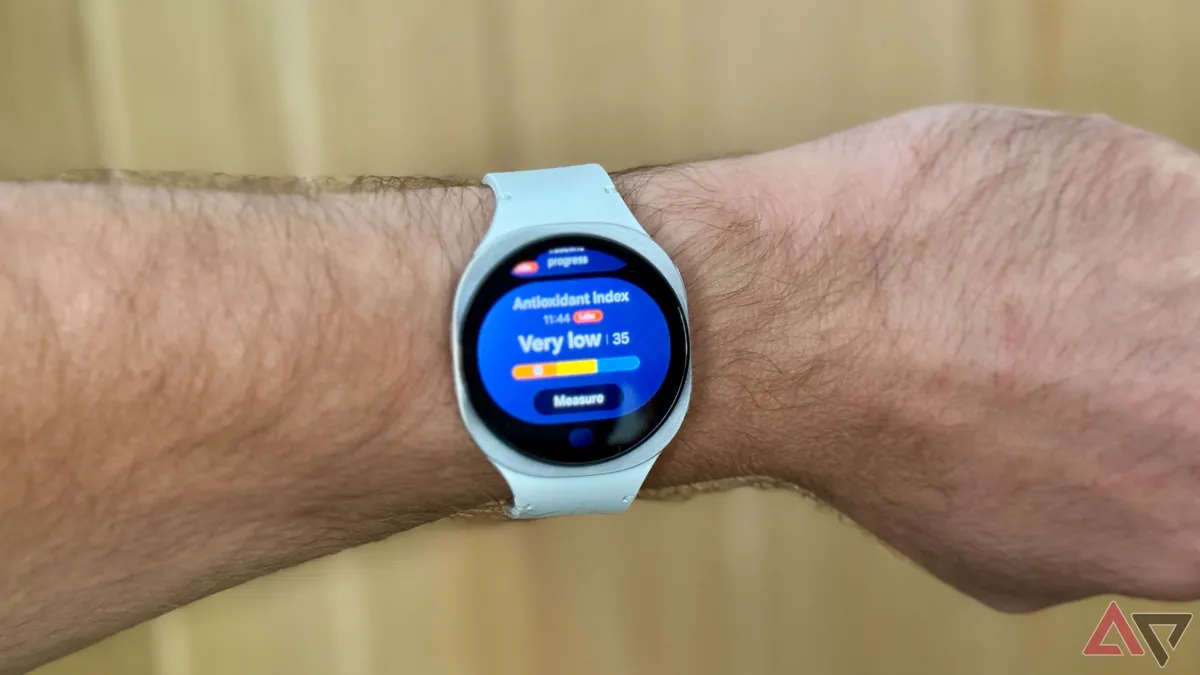
One of the standout health features of the Samsung Galaxy Watch 8 is its innovative Antioxidant Index test. This test is designed to measure the levels of carotenoids—antioxidants that are stored in your skin—helping users make informed decisions for a healthier lifestyle. However, unlike other health monitoring features, the Antioxidant Index test requires you to remove the watch from your wrist, raising the question: is it really worth the effort? After my own experience, I found that the results may not always be what you expect, and there are important considerations to keep in mind.
The Antioxidant Index test takes a holistic approach to health, focusing on aging and the factors that contribute to accelerated aging. Behaviors such as alcohol consumption, smoking, UV exposure, stress, and lack of sleep can increase the presence of free radicals in the body, leading to cellular damage. Antioxidants, found in many nutritious foods, work to neutralize these free radicals, thereby helping to prevent chronic illnesses and promoting healthy aging.
According to Samsung, monitoring your carotenoid levels can be crucial for your long-term health. Utilizing the BioActive Sensor located on the back of the smartwatch, the test can provide results in just a few seconds. The results are displayed in the Samsung Health app, where your antioxidant level is scored out of 100 and categorized into three levels: very low, low, and adequate. If your score falls on the lower end, Samsung suggests increasing your intake of vegetables and healthy juices. Keep in mind, though, that it may take weeks of consistent healthy choices before any improvements are reflected in the test results.
To access the Antioxidant Index test, you need to manually add it to your list of health features on the Galaxy Watch 8, as it is not included by default. This feature is categorized under Samsung Labs, similar to the new Vascular Load measurement, and is considered a preview feature. Therefore, it is important to note that the results may not be medically validated.
Once you have added the feature, simply tap the "Measure" button to begin. The process involves taking off your watch and placing your thumb on the sensor at the back. Although the procedure might seem a bit cumbersome, it only takes a few seconds to initiate and complete the measurement. The results are displayed instantly in the app, allowing for quick feedback.
After taking the test, I discovered that my Antioxidant Index score fell at the very low end of the scale, which is certainly not ideal. However, the app provided detailed recommendations for improving my score, such as consuming a quarter of a zucchini or five lettuce leaves. Additionally, you can track your average scores over various timeframes, including weekly, monthly, and yearly averages.
While removing the Galaxy Watch 8 for the Antioxidant Index test is a simple task, it is notably different from other health tests available on smartwatches, such as electrocardiograms (ECGs) and blood pressure readings, which can be taken while wearing the watch. Samsung’s choice to utilize the thumb for this test, rather than the wrist, is to ensure that the sensor accurately reads skin composition rather than blood vessels.
However, the very concept of the Antioxidant Index test raises some concerns. A low score can trigger a natural human response to seek quick fixes, potentially leading to unnecessary purchases of antioxidant-rich products. Although I understood the importance of maintaining a healthy lifestyle, the low reading was concerning enough to make me consider rapidly incorporating more antioxidants into my diet.
My initial reaction prompted me to conduct further research on antioxidants and free radicals. I stumbled upon an insightful article from Harvard Health that challenged the direct link between antioxidant levels and the need for expensive supplements. Instead, it reinforced the notion that a diet rich in fruits and vegetables naturally provides the benefits we seek from antioxidants.
Moreover, the Free Radical Theory of Aging is increasingly under scrutiny. It seems that simply consuming antioxidant-rich juices may not significantly enhance long-term health outcomes. Research indicates that avoiding sources of free radicals—such as smoking and excessive alcohol consumption—could be more beneficial than seeking out antioxidant products.
Ultimately, the consensus from my readings is that maintaining a balanced diet is key. Rather than splurging on high-priced antioxidant supplements, it is more prudent to focus on a wholesome diet that includes plenty of fruits and vegetables. My experience with the Antioxidant Index test reinforced what I already knew: a healthy lifestyle is the best approach for achieving long-lasting health benefits.
In the end, the Antioxidant Index test may serve as a conversation starter about health and wellness, but it should not dictate your lifestyle choices. If you decide to modify your diet, consider revisiting the test in a few months to see if your score improves. However, it is essential to remember that the age-old advice of eating well and living healthily remains the most effective strategy for a long and healthy life.